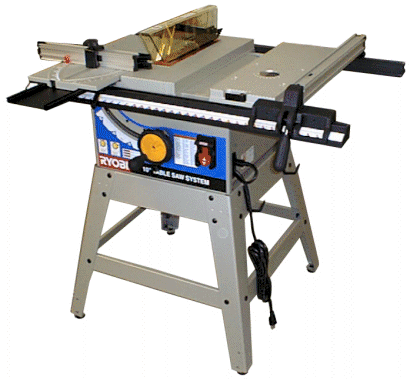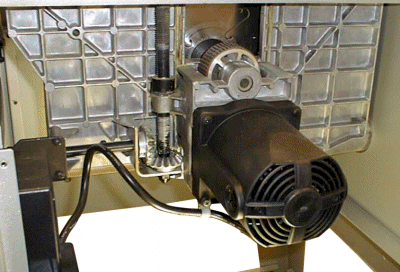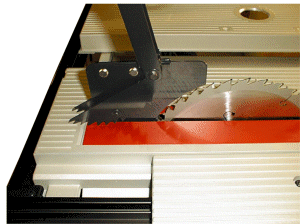|
|
|
| Description The Ryobi BT3100 Tablesaw is a right-tilt Compact saw powered by a 15amp universal motor; it is similar in form to many small saws available in Europe. It is relatively light weight (about 100lbs) as it is made largely of sheet metal and aluminum castings. It incorporates several features not commonly found on tablesaws in this market. The most obvious of these is a small sliding table (Ryobi calls it the SMT). Another very important feature of the BT3100 is its cost, it's only about $300. The BT3100 is the successor to the BT3000 model and incorporates a few changes. One of these are the redesigned shims which are part of the blade raise mechanics. On the BT3000 problems with the shims could involve a major repair operation, the new design should eliminate that. |
 |
| The BT3100 is relatively small, its footprint is only 8.5 square feet. If shop space is limited, this will take up very little of it. The table depth is a little on the short side at 22", the total table surface area is about 4 square feet. The table height is 38", this is a little on the tall side; most saw tables are around 34". | |
|
In a typical configuration, the rip capacity of the saw is about
24". Depending on placement of the rails, rip capacity can be increased a little more
than this. The rip fence locks down very securely on the front and at the back end
as well. This is useful when stock hold downs are attached to it as the fence will
not lift up as stock is pushed through. The fence also lifts off anywhere along the
rail. The SMT has a small stroke as sliding tables go but it compares favorably to more common miter gauges. It slides about 2.5" away from the blade, this close proximity to the blade is an asset. The SMT even includes an 18" crosscut fence; oddly (to me anyway), most other tablesaws do not include a crosscut fence as a standard item. The crosscut fence is positioned towards the middle of the table, it provides a very useable ~16" of crosscut capacity. |
| The auxiliary table has a 2 7/16" hole in the surface and is designed to accommodate a router or jigsaw so it would be relatively easy to add these functions within the footprint of the saw. There is an accessory kit with a router / jigsaw adapter plate and a router fence that installs onto the rip fence. The BT3100 has a 10 foot long 14 gauge power cord and also includes a very good thin kerf carbide blade. |
| The BT3100 has a single crank to control both raise
and tilt; the mode is controlled by a lever behind the crank. The blade raise function is
fairly high resolution at 12 turns per inch of raise. The tilt function is course at about
3 revolutions for 45 degrees of tilt. There are internal adjustable stops for blade angle.
Despite the combined crank function, both the raise and tilt functions are accurate and
easy to operate. |
 |
| Assembly The BT3100 comes in a single large box and is well packed. The instructions are clear and assembly is pretty easy; I put it together in an hour and 40 minutes. As manuals go this one is pretty good. It is trilingual, about 51 pages in English. It includes assembly, setup, use, troubleshooting, and parts diagrams. The alignment took me about an hour to complete. This is because there is more to align and because it does not incorporate many alignment aids. You don't really "dial-in" the alignment on this machine so much as you fiddle with it until you get lucky. I don't recommend the process described in the manual, there are better techniques that will yield far more accurate results. I don't place a lot of stock in the nickel test but I'll report what I found. Basically, a nickel would stand on-edge with the machine running about 50% of the time, otherwise it would move a bit or fall over. Accuracy |
| Slots - The Lack Thereof There are those that may note the lack of a miter gauge slots as a negative but since the machine has a sliding table, it really doesn't need them (to operate). This may be a radical idea to most readers but I've been "miter gauge slot-free" for quite a while and know this to be true. Certainly there are a multitude of aftermarket accessories designed to use miter slots and in the stock machine configuration you will not be able to use them. Those that might be useful are feather boards and tenon jigs. While it is an issue, it isn't that big of one. It is still possible to use a feather board, you will just need to build your own and attach it to the SMT. As for tenon jigs, you would be able to make one that uses the rip fence or the SMT. Just because you cannot use a miter slot dependant jig doesn't mean that you cannot find that capability through some other means. If that isn't good enough, you can buy the Ryobi miter slot accessory or make your own to install on the machine. |
| In Use The SMT is an uncommon but very handy feature of the machine. It allows stock to be crosscut more easily and safely. The crosscut fence can be very easily removed and replaced. this is very important because it will need to be removed for some rip cuts. The crosscut fence does not include a flip stop or measuring device which would be very helpful. The SMT does have a lock to keep it in a fixed position. The BT3100 is a bit challenged when cutting full sheets of plywood. There are three reasons for this, one is because of its lighter weight (hence stability), it weighs about as much as a sheet of particle board. The other is that it's rip fence is a little short (less guidance). And the last is because its support area (extended) is small (about 20% less than a steel wing contractor saw). Ripping a full sheet of plywood is hard enough on big saws though. My recommendation (and common sense) is to break plywood into more reasonable sections before trying to cut them on a tablesaw. Cutting big sections on the BT3100 can be done, good infeed and outfeed supports should be used and more care on guiding the cut. The 15 amp universal motor is not as powerful as a 1.5hp induction motor. When cutting, I notice an rpm decrease even on easy to cut material. However, the slowdown does not continue anywhere near to the point of stall under normal conditions. The only real effect is that you need to slow the feed rate to compensate; I've not been able to bog down the motor with any reasonable cutting. I've been able to cut a 3/4" wide and 5/8" deep groove with a 6" dado stack so obviously the saw has enough power to do its job. High speed blades and slow feed rates can lead to burned stock though (particularly in Cherry), a sharp blade will reduce this. Due to the universal motor and the blade tip speed the machine is quite loud. I normally wear (and recommend) ear protection, I wouldn't operate this machine without it. |

|
Under the
Hood The arbor uses a couple of spacers on the right side to bush the blade out. These spacers would be removed when a dado blade or moulding cutter head is used. Two wrenches are used to accomplish blade changes; one wrench fits onto the arbor shaft flats and the other around the arbor nut. I don't want to make a big deal out if it but this is a little nicer than the typical "jam the blade against some scrap" blade changing technique. |
Unlike nearly all other saws available in this market, the BT3100 uses a riving knife instead of a splitter. A riving knife moves with the blade instead of remaining at a fixed height. A riving knife is usually closer to the blade as well. This design also has a guard and kick-back pawls attached to it, the guard does a reasonable job of keeping chips from being thrown at the user. Removing the riving knife (for certain cuts it would be required) is fairly simple and it installs easily but not speedily. Care should be taken to ensure it is installed properly so that it will not contact the blade. A well thought out shim design allows the knife to be aligned correctly. |
 |
| The cast aluminum tables are coated with some form of (not particularly smooth) paint. Of course the tables won't rust but the paint will prevent oxidation too. Without any treatment this surface can mark up stock just like bare aluminum can. I sanded the top of the machine with 320 grit sandpaper and waxed it; this now prevents any marking. Because it is aluminum though you will of course not be able to use magnetic base accessories with this machine. | |
| Summary One has to evaluate the BT3100 in the proper context. It isn't in league with a cabinet saw or even a contractor saw but it also isn't anywhere near as expensive as these units either. The machine is sturdy but it isn't built like a tank so some normal care in handling is in order. It also has some nice features (namely the SMT & riving knife) but will also require more time and skill to align. It has a very small foot print so it won't take up much space. I've listed several facts and figures in this review but one of the most important one to keep in mind is the $300 price tag. For this price the saw is quite a performer and if you are shopping for a saw on a tight budget you would be hard pressed to find one with these features anywhere near this price. Although it is smaller and less powerful than some other machines, the bottom line is that it will in fact cut wood quite well. |
In the interest of full disclosure Ryobi provided this product to facilitate this review. More information about the BT3100 is available at this link. |